Comspec, a Java Based Development Environment for Communication Aids
Mats Lundälv
DART, Bracke Ostergard, Box 21062,S-418 04 Goteborg,
Sweden
tel: +46 31 502 607
fax:+46 31 53 23 07
email: mats.lundalv@bracke.goteborg.se
Co-authors:
Doeko Hekstra
managing director of HANDICOM, Harderwijk, the Netherlands
Erlend Stav
research scientist, SINTEF Telecom &Informatics, Oslo, Norway
1. Summary
Comspec is an open platform for building modular AAC software. Based on the Java platform, Comspec provides standards for component development, software for creating and running AAC applications, and sample components and applications. Thus the rehab industry can cooperate and compete on a common basis in the creation and provision of "building blocks" for rehab professionals and facilitators to compose and maintain communication aids for a widening range of users and user needs.
2. Introduction
Users of Alternative and Augmentative Communication (AAC) need devices that can be easily tailored to their particular requirements, in a constantly changing environment. They also request a smooth integration of a growing range of aids supporting communication, environmental control, educational, work and leisure time activities.
This broad and diverse variety of individual needs presents a difficult challenge to manufacturers and other service providers. Economically and technically it is difficult to produce, maintain, and support products which meet these needs.
Comspec responds to these challenges by offering an open platform for building modular AAC software. Comspec applications are built from a set of interacting "building blocks" called components. Based on a published set of standards, the rehab industry can create new components for specific and emerging needs. These new components can be combined with previously produced ones. In this way the range of possible applications that can be provided based on the Comspec environment can be dramatically extended over time.
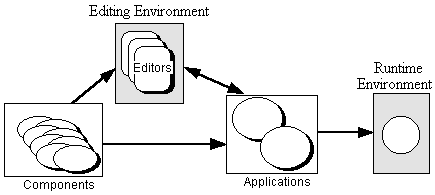
Figure 1: The Comspec Environments - - how Components are used in the Editors to create Applications
Comspec applications can be run using either a Runtime or an Editing Environment. The editing environment provides a set of tools allowing rehabilitation professionals and facilitators to build, configure and adapt AAC applications for individual user needs. These tools include Configuration, Layout, Vocabulary and Toolbar editors and are described in more detail below.
3. Comspec Users
The Comspec system is designed and presented in a layered structure hiding technical complexity which is not relevant for most users. Four different user roles have been identified: End-users who will require highly functional and flexible aids - well tailored to their specific needs, without having to know about any technical details of the application they are using; Facilitators who will need to make day-to-day adjustments and minor changes to existing Comspec applications;
System Integrators who will make more radical changes to an existing application, or create new Comspec applications from scratch;
Component Developers who will create new Comspec modules which are made available to Integrators either commercially or in the Public Domain.
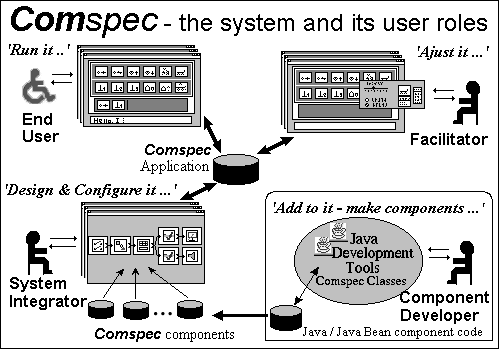
Figure 2: Users and User Roles
4. Comspec Applications
4.1 Overview
The appearance and behaviour of a Comspec Application is defined by the content of four different subsystems; the Configuration, the Layout, The Vocabulary and the Toolbar.
(See figure 3 below.)
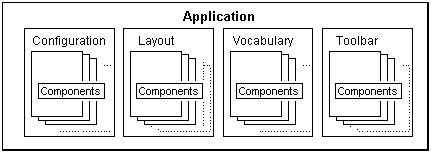
Figure 3: The SubSystems of a Comspec Application
4.2 The Configuration
The Configuration contains the information about which technical components are included in the system and how they are interconnected. The Configuration Editor is the tool for selecting, linking and configuring the basic functional components of an AAC application. The following Figure 4 shows a screen shot of a configuration built from a typical set of configuration components including a switch input, a scanning selection method, a selection set, filters and outputs. The SelectionSet and and Layout Output components contain references to layout components used to create the user interface in the Layout part of the Application. Filters can be used for fine-tuned control over the content and timing of output.
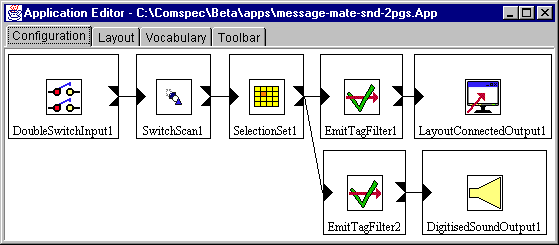
Figure 4: The Configuration Editor
4.3 The Layout
The Layout Editor is the tool for the design and refinement of the user interface of the aid. The Layout can be paged. Each page can contain Outputs and Card Stack components which also serve as containers of Simple Components. In this way hierarchical selection sets can be constructed. The simple components are linked to Vocabulary Items in the Vocabulary, and suitable representations are chosen for display. See Figure 5 below.
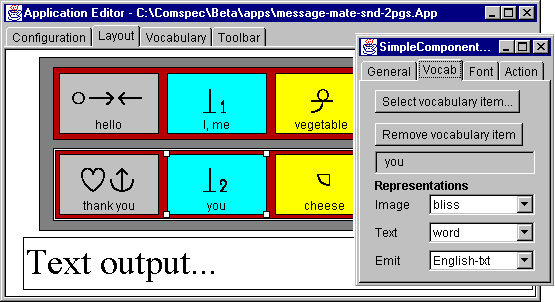
Figure 5: The Layout Editor
4.4 The Vocabulary
The Vocabulary Editor is the tool for managing the language resources of the AAC system. Each Vocabulary Item can be equipped with a choice of representations of different modalities (text, graphic, sound, etc.). New representation/media types can be defined subsequently.
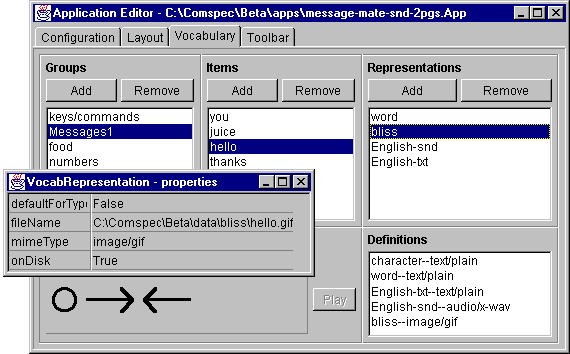
Figure 6: The Vocabulary Editor
4.5 The Toolbar
The Toolbar Editor is the editor for the design of the Facilitator Toolbar. Functions and settings needed for day-to-day adjustments, and which are buried in the different sub-systems, can be selected and presented together for the non-technical user - see Figure 7 below.
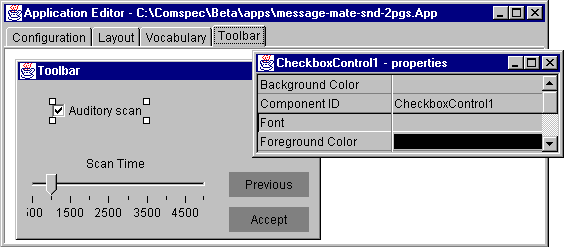
Figure 7: The Toolbar Editor
4.6 A concept for re-use and extendibility
All four Comspec editors support separate storage (and consequently export and import) of sub-system data. For example a layout can be imported from another application. This encourages re-use, distribution and sharing of ideas and work between applications and developers.
All four sub-systems, and in fact the editors themselves, are designed to be readily and separately maintained and extended by adding new functional components etc.
5. Conclusions
The first version of Comspec was designed and developed using the OpenDoc platform. Because support for OpenDoc was frozen, the current version has been re-designed and re-developed using the Java/JavaBeans technology of Sun Micro Systems. This software environment, beeing rapidly adopted, will make it possible to provide Comspec components and applications for the major operating system platforms, such as Windows 95/NT, MacOS and UNIX, as well as for web browsing applications over the Internet. The Java platform is now also introduced for a rapidly growing range of standard or dedicated devices like PalmTops, PDAs, Interactive Television equipment etc. This is a big advantage for the rehab industry and other service providers, as well as for end-users and facilitators: Comspec components and applications need to be developed only once, and can with minimal modifications be made available for an increasing variety of different computing platforms and purposes.
The outcome of the Comspec project clearly confirms the value and usefulness of an open and modular software platform for future development of AAC and access sysetms. Despite the problems and delays caused by dependencies on immature leading-edge technologies, a good foundation for further development has been produced. The commercial and non-commercial partners of the Comspec Consortium are eager to use and add to the resources provided in the current Comspec software package for our future development work. We invite all interested parties to join us in this effort. The successful future of Comspec depends on a critical mass of developers adopting Comspec as part of their future strategies.
The Comspec software, source code, documentation and contact information is published on the Comspec Web site: www.oslo.sintef.no/comspec/
Note: All screen shots are from an early Beta version. The appearance of some editors will change.
References
- Comspec Phase 1 and Phase 2 Reports (D.Svanæs, P.Poon, J.P.Odor, M.Lundälv, et al.), DART, Bräcke Östergård, Box 21062, S-418 04 Göteborg, Sweden, 1990 and 1992
- Connecting External Systems to Comspec Aids - A Report to the Comspec Working Group (J.P.Odor) CALL Centre, University of Edinburgh, 1992
- Comspec - Toward a Modular Software Architecture and Protocol for AAC Devices (M.Lundälv et. al.) Proceedings of the First TIDE Congress, TIDE Office, Rue de la Loi 200, EC-DGXIII/C/5 -BU 29-3/81, B-1049, Brussels, IOS Press1993
- Comspec - The Advent of an Integrated Modular Communication System (M.Lundälv) Proceedings of the Future Integrated Solutions Conference, ACE Centre, Oxford, 1994
- Comspec - a Modular and Open Software Platform for AAC Aids on the Drawing-Board (M.Lundälv ) Proceedings of the Second TIDE Congress (Ed. I. Placencia Porrero, R Puig de la Bellacasa) TIDE Office, Rue de la Loi 200, EC-DGXIII/C/5 -BU 29-3/81, B-1049, Brussels: IOS Press ISBN 90 5199 220 3 1995
- 'Trees in the Forest' or 'Seeing the Wood for the Trees', (P. Fuller, A. Lysley, D. Colven) Proceedings of the Second TIDE Congress (Ed. I. Placencia Porrero, R Puig de la Bellacasa) TIDE Office, Rue de la Loi 200, EC-DGXIII/C/5 -BU 29-3/81, B-1049, Brussels: IOS Press ISBN 90 5199 220 3 1995
- Developing Comspec in the World of OpenDoc (S. Tyvand, H. Stegavik, E. Stav) Proceedings of the ECART3 Conference, Lisbon, October 1995, ISBN: 972-9301-18-2
- D.Colven, M.Lundälv, From SAW to Comspec - Mini Seminar, Proceedings of the 7th Biennial Conference of ISAAC, Vancouver, B.C., Canada, August 7 - 10 1996.
